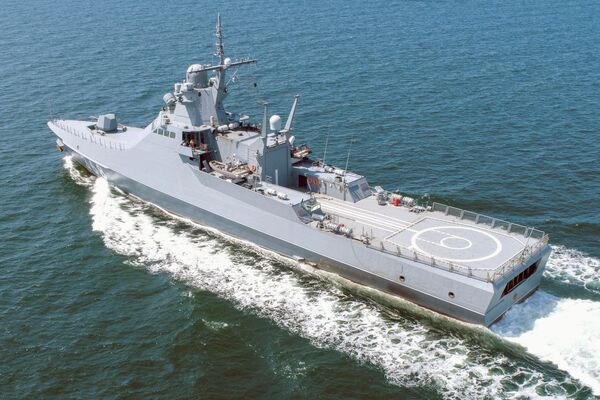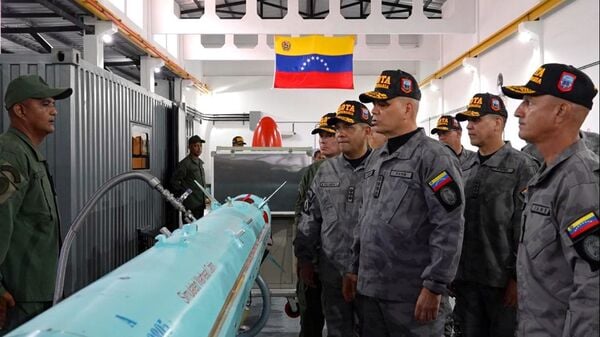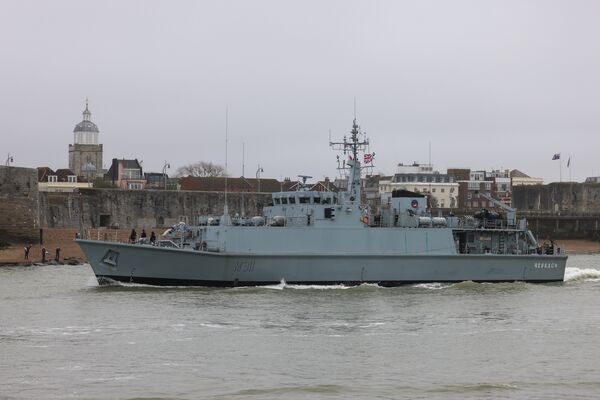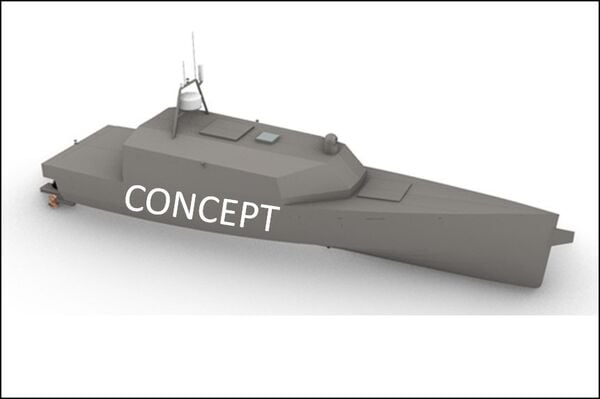- About
- Intara
- Capabilities
- Advisory
- Resources
- News
- Store
Russian attacks on Ukraine's coast threaten loss of key naval bases as well as critical shipbuilding facilities
25 February 2022
by Manash Pratim Boruah & Prathamesh Karle & Kate Tringham


The Russian Navy's Bykov (Project 22160)-class corvette Vasily Bykov, one of two ships involved in the attack on Snake Island. (Michael Nitz/Naval Press Service)
Russian forces captured Zmiinyi (Snake) Island during the first day of its invasion of Ukraine, the State Border Guard Service of Ukraine confirmed on 25 February.
The Ukrainian island is located in the Black Sea near the Danube Delta, about 70 n miles from Odessa, and plays an important role in delimiting Ukrainian territorial waters.
During the confrontation with Russia on 24 February, all 13 border guards defending the island were killed, Ukrainian President Volodymyr Zelensky said in a video message on 25 February.
The Ukrainian Ministry of Defence confirmed that the attacks on the island were carried out by air and sea, with the ships involved being the Slava (Project 1164)-class cruiser Moskva and the Bykov (Project 22160)-class corvette Vasily Bykov.
Meanwhile, the Ukrainian Navy continues to defend the southwestern part of the country's Black Sea coast, Ukrainian Armed Forces confirmed on 25 February. The forces are facing simultaneous attacks by Russian forces on the bases and ports of Odessa, Yuzhny, and Ochakiv. A Turkish-owned commercial vessel, Yasa Jupiter , was hit by a bomb off the coast of Odessa on 24 February while on its way to Romania, Turkey's General Directorate of Maritime Affairs stated on its social media account.
In a video message to Mykolaiv residents on 25 February, chairman of the Mykolaiv state regional administration Vitaly Kim said the region continues to defend itself and has not surrendered. At least four soldiers were wounded in explosions at the Ochakiv naval base in Mykolaiv region on 24 February, Kim said. Ochakiv is the headquarters of the navy's 5th Brigade of Surface Ships and was envisaged to be upgraded to host NATO and allied vessels during joint exercises.
In the Sea of Azov, Russia conducted missile strikes on the coastal town of Prymorskyi Posad in the Zaporizhizhia oblast on 25 February, the State Border Guard Service of Ukraine stated on its social media account. An air defence base in Mariupol was also reportedly under Russian strikes on 24 February. Attacks have also been reported on 25 February in Berdyansk, the site of the Vostok naval base currently being constructed.
In addition to Moskva and Vasily Bykov , the Admiral Grigorovich-class Admiral Essen is also operating in the Black Sea. There are also 13 large Russian Navy landing ship tanks (LSTs) and another five smaller landing craft operating in the Black Sea region, some of which are in the Sea of Azov. In video footage posted by Ukrainian media outlet MyKerch on its VKontakte social media account on 21 February, more than 10 Russian Navy warships could be seen headed towards the Sea of Azov through the Kerch Strait. The ships include the 184th Water Area Protection Brigade's Grisha-class corvette Eisk , the Bykov-class corvette Pavel Derzhavin , the 197th Landing Ship Brigade's (Project 775)-class landing ships Tsesar Kunikov and Novocherkassk , the Alligator (Project 1171)-class landing ship Saratov , the 41st Missile Ship Brigade's Tarantul (Project 12411)-class corvette Neberezhnye Chelny , and an unidentified tug heading north through the Kerch Strait into the Sea of Azov on 21 February.
As of 15 February there are at least 19 Russian Navy ships in the Mediterranean, including the two Slava-class cruisers ( Varyag and Marshal Ustinov ), two Udaloy (Project 1155) destroyers ( Admiral Tributs and Vitse Admiral Kasatonov ), the Project 11356M frigate Admiral Grigorovich and the Admiral Gorshkov (Project 22350)-class frigate Admiral Kasatonov , a Buyan-M (Project 21631)-class corvette, two Kilo (Project 636)-class submarines (one confirmed as Krasnodar ), and other assorted vessels, including a minesweeper, an intelligence ship, tugs, and tankers.
NATO secretary general Jens Stoltenberg stated on 24 February that NATO had more than 120 allied ships “from the high north to the Mediterranean and more than 100 jets on high alert”, however, there are currently no NATO naval assets providing reinforcement in the Black Sea itself. For the past few weeks three NATO carrier strike groups (CSGs) have been operating in the Mediterranean Sea on exercises: the US Navy's Harry Truman CSG, the French Navy's Charles de Gaulle CSG, and the Italian Navy's Cavour CSG.
Venezuela displays Iranian anti-ship missiles
19 April 2024
by Jeremy Binnie


Venezuelan Defence Minister Vladímir Padrino López inspects a CM-90 anti-ship missile. (Ministerio del Poder Popular para la Defensa (Venezuela))
The Venezuelan military confirmed on 16 April that it has the CM-90 export version of Iran's Nasir anti-ship missile (ASM).
Defence Minister Vladímir Padrino López inaugurated what a defence ministry statement described as a workshop for the CM-90 at Base Naval CA Agustín Armario in Puerto Cabello as part of the Bolivarian Navy of Venezuela's (ABV's) anniversary celebrations on that day. It released photographs and a video of Padrino inspecting several ASMs and associated containerised testing equipment inside a building.
The Nasir was developed from the Nasr missile, which is Iran's version of the Chinese C704, with the solid-propellant motor replaced by a turbojet engine and a launch booster. Iranian export documentation says this makes the CM-90 88 cm longer than the CM-35, the export version of the Nasr, and increases its range from 35 to 90 km.
Ukrainian ex-Royal Navy minehunters to be temporarily based in Portsmouth
19 April 2024
by Kate Tringham


Cherkasy, one of the Ukrainian Navy's two newly acquired ex-Royal Navy Sandown-class MCMVs, is pictured entering Portsmouth Harbour on 11 April ahead of a series of multinational naval exercises. (Crown copyright)
The Ukrainian Navy's two newly acquired ex-Royal Navy (RN) Sandown-class mine-countermeasures vessels (MCMVs) have been temporarily homeported at Portsmouth Naval Base, the RN has confirmed.
The two minehunters, Chernihiv (ex-HMS Grimsby ) and Cherkasy (ex-HMS Shoreham ), arrived at Portsmouth Naval Base on 11 April ahead of a series of multinational exercises.
Previously based in Scotland, the ships will operate from Portsmouth “for the foreseeable future”, the RN said. While stationed in Portsmouth, they will engage in exercises with the RN and the US Navy (USN) in UK waters, helping the Ukrainian Navy to adapt to NATO operations.
Chernihiv and Cherkasy, which were recommissioned into Ukrainian Navy service in July 2023, were donated by the UK to Ukraine as part of the Ukraine Naval Capabilities Enhancement Programme (UNCEP). Ahead of their transfer from the RN, they were overhauled by Babcock at its facilities in Rosyth, Scotland.
Netherlands MoD and Dutch Naval Design team to collaborate on USV development
19 April 2024
by Kate Tringham


The USV concept. (Dutch MoD)
The Netherlands Ministry of Defence (MoD) and Dutch Naval Design (DND) have joined forces to develop an unmanned surface vessel (USV).
Announcing the partnership on 12 April, the MoD said the USV will be designed for deployment from the future anti-submarine warfare frigates (ASWFs) currently under development.
Under the terms of the contract, signed on 10 April, the USV is planned to be completed in around four years, the MoD said. The 12 m long vessel will be “technologically very advanced, sustainable, autonomous, and operationally flexible”, it added.
The Belgian and Dutch navies are procuring two ships each to replace their respective Karel Doorman (M)-class frigates under the ASWF programme. The ships are being designed and built by Damen under a contract awarded by the Dutch Materiel and IT Command (COMMIT) in June 2023. Under the terms of the contract, the first frigate will be delivered to COMMIT in 2028 and handed over to the Dutch navy in 2029, while the Belgian Navy will receive its first ship in 2030.
Russian forces captured Zmiinyi (Snake) Island during the first day of its invasion of Ukraine, the ...
Latest Podcasts
Iran Israel analysis
In this podcast Janes analysts discuss the Iranian attacks on Israel on the 14 April. They highlight the military systems used by Iran and the performance and impact of these on Israel. They also discuss the implications of this attack goi...
Listen nowJanes Case Studies
Using Janes Intara to build a common intelligence picture: Russian build up on the Ukrainian border
View Case StudyNews Categories
 Security Details
Security Details